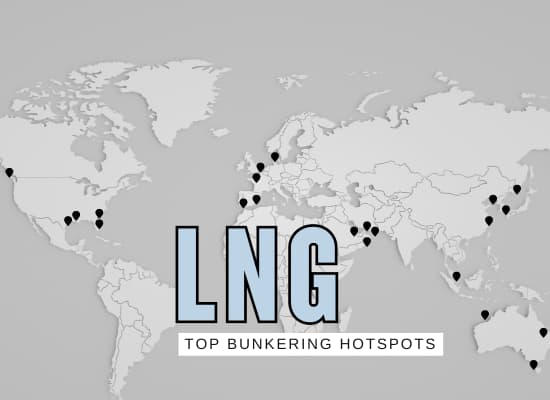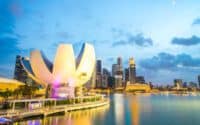LNG Bunkering Hotspots: Top Ports in Europe, Asia & Beyond

As the shipping industry shifts toward cleaner fuels, LNG bunkering is rapidly expanding across key global ports. With increasing environmental regulations and the push for lower-emission alternatives, more shipowners are turning to liquefied natural gas (LNG) to power their fleets. But not all ports are equal when it comes to LNG availability, cost, and infrastructure.
Today, we highlight five of the leading LNG bunkering hubs in Europe, Asia, North America, the Middle East, and Australia—key locations where ship operators can refuel efficiently while keeping costs in check.
We welcome your feedback, suggestions, corrections, and ideas for enhancements. Please click here to get in touch.
Europe / Asia / North America / Middle East / Australia
🇪🇺 Europe: Top LNG Bunkering Ports
LNG bunkering in Europe is expanding fast, driven by strict emissions regulations and rising fleet demand. While some ports offer competitive pricing, others see higher costs due to infrastructure investments and environmental levies. Below are five of the most important LNG bunkering hubs in Europe, with insights on their infrastructure, regulations, notable operators, and cost trends.
| ShipUniverse: Top LNG Bunkering Ports in Europe | ||||
|---|---|---|---|---|
| Port | Infrastructure | Regulations | Notable Operators | Cost Trends |
| Rotterdam, Netherlands 🇳🇱 | Europe's largest LNG bunkering hub, featuring multiple facilities, including the Gate LNG terminal. The port reported a 52% increase in LNG demand, reaching 0.94 million cubic meters in 2024. | Complies with stringent EU FuelEU Maritime regulations, promoting LNG as a transitional fuel. | Shell, Titan LNG, Gasunie, Vopak | Moderate to high; influenced by increasing demand and stringent environmental policies. |
| Zeebrugge, Belgium 🇧🇪 | Major LNG terminal handling imports and transshipments, offering both ship-to-ship and truck-to-ship bunkering. Recent EU sanctions targeting Russian LNG may impact operations. | Adheres to EU environmental policies; upcoming restrictions on Russian LNG could affect supply dynamics. | Fluxys | Low to Moderate; potential fluctuations due to geopolitical factors and supply chain adjustments. |
| Barcelona, Spain 🇪🇸 | Leading LNG bunkering port in Spain, with a 60% increase in LNG bunker demand, reaching 229,750 m³ in 2024. | Complies with EU environmental regulations promoting LNG as a marine fuel. | Enagás, Shell | Moderate; competitive pricing supported by growing demand and established infrastructure. |
| Gibraltar 🇬🇮 | Strategic bunkering hub between the Atlantic and Mediterranean, offering LNG bunkering through ship-to-ship transfers. | Adheres to International Maritime Organization (IMO) and EU emission reduction standards, encouraging alternative fuels like LNG. | Peninsula | Moderate; strategic location offers competitive pricing for vessels transiting major shipping lanes. |
| Brunsbüttel, Germany 🇩🇪 | Hosts the Elbehafen LNG terminal, a key facility for LNG bunkering in northern Europe. | Follows German national and EU environmental policies, encouraging LNG adoption. | Brunsbüttel Ports GmbH | Moderate; pricing is stable but influenced by European gas market fluctuations. |
🇦🇸 Asia: Top LNG Bunkering Ports
Asia's maritime industry is rapidly adopting Liquefied Natural Gas (LNG) as a cleaner fuel alternative, driven by stringent environmental regulations and a commitment to sustainable shipping practices. Several key ports have emerged as leaders in LNG bunkering, offering robust infrastructure and services to meet the growing demand.
| ShipUniverse: Top LNG Bunkering Ports in Asia | ||||
|---|---|---|---|---|
| Port | Infrastructure | Regulations | Notable Operators | Cost Trends |
| Singapore 🇸🇬 | The world's largest LNG bunkering hub, with extensive infrastructure including ship-to-ship and terminal-to-ship operations. Singapore saw a record 54.92 million metric tons of marine fuel sales in 2024, reflecting its growing LNG adoption. | Stringent environmental policies and mandatory digital bunkering notes starting in April 2025 for increased transparency. | MPA Singapore, Pavilion Energy, FueLNG | Moderate to high; pricing influenced by global LNG supply fluctuations and port service costs. |
| Shanghai, China 🇨🇳 | Yangshan Port in Shanghai is China's largest LNG bunkering port, handling over 444,000 cubic meters of LNG in 2024, a 73% increase from the previous year. It ranks as the third-largest LNG bunkering port globally. | China’s national environmental policies strongly support LNG adoption, in line with IMO regulations. | ENN Energy, China National Petroleum Corporation | Low to Moderate; competitive pricing due to domestic LNG production and government support. |
| Busan, South Korea 🇰🇷 | South Korea’s largest port, ranking sixth globally in bunkering volume. The port supplied 5.78 million metric tons of marine fuel in 2023 and is investing heavily in LNG bunkering facilities. | Follows South Korea’s environmental targets and IMO regulations promoting LNG as a marine fuel. | Korea Gas Corporation (KOGAS), Busan Port Authority | Moderate; stable pricing supported by government incentives for LNG-powered vessels. |
| Hong Kong 🇭🇰 | A key bunkering port in the Asia-Pacific region, benefiting from its strategic location and high shipping traffic. The port is expanding its LNG capabilities to meet global sustainability trends. | Complies with IMO regulations and Hong Kong’s air pollution control policies encouraging LNG use. | Shell, ExxonMobil | Moderate; competitive pricing due to well-established infrastructure and regional demand. |
| Zhoushan, China 🇨🇳 | China's largest overall bunkering port, supplying over 7.04 million metric tons of fuel in 2023. It is undergoing major LNG infrastructure upgrades to support increased demand. | Aligned with China’s carbon reduction goals and global maritime emissions standards. | CNOOC, China Gas Holdings | Moderate; pricing influenced by domestic LNG supply and evolving government policies. |
🇨🇦 North America: Top LNG Bunkering Ports
North America's maritime industry is increasingly embracing Liquefied Natural Gas (LNG) as a cleaner alternative to traditional marine fuels. Several ports across the continent have developed robust LNG bunkering infrastructures to support this transition. Below is an overview of the top five LNG bunkering ports in North America:
| ShipUniverse: Top LNG Bunkering Ports in North America | ||||
|---|---|---|---|---|
| Port | Infrastructure | Regulations | Notable Operators | Cost Trends |
| Vancouver, Canada 🇨🇦 | Conducted its first LNG bunkering operation in March 2025, with Mitsui OSK Lines bunkering its LNG-fueled car carrier in English Bay. | Adheres to Canadian environmental regulations and international standards promoting LNG as a marine fuel. | Seaspan, FortisBC | Moderate to high; pricing influenced by regional LNG supply and infrastructure development. |
| Jacksonville, Florida, USA 🇺🇸 | Home to the JAX LNG facility, operational since 2018, offering ship-to-ship and truck-to-ship LNG bunkering services. The port has access to two LNG bunker barges, the Clean Canaveral and Clean Everglades, serving multiple customers in the southeast United States. | Complies with U.S. Coast Guard and Environmental Protection Agency (EPA) regulations promoting LNG as a marine fuel. | JAX LNG, Seaside LNG | Moderate; competitive pricing due to domestic LNG production and established infrastructure. |
| Port Fourchon, Louisiana, USA 🇺🇸 | A key Gulf Coast port supporting offshore oil and gas operations, offering LNG bunkering services to various vessel types. | Adheres to federal and state environmental regulations encouraging the use of cleaner marine fuels like LNG. | Energy World USA | Low to Moderate; pricing benefits from proximity to natural gas production and processing facilities. |
| Houston, Texas, USA 🇺🇸 | A major bunkering port with vast refining capacities, making strides in LNG bunkering to become a leader in alternative marine fuels. | Complies with stringent environmental regulations promoting LNG as a cleaner marine fuel. | Port of Houston Authority | Moderate; competitive pricing due to proximity to refining capacities and infrastructure development. |
| Savannah, Georgia, USA 🇺🇸 | Recently initiated LNG bunkering operations, with the inaugural bunkering of the CMA CGM Symi conducted by JAX LNG and Seaside LNG. | Follows federal and state environmental policies promoting LNG as a marine fuel. | JAX LNG, Seaside LNG | Moderate; pricing influenced by emerging infrastructure and regional LNG supply. |
🇦🇪 Middle East: Top LNG Bunkering Ports
The Middle East is rapidly developing its Liquefied Natural Gas (LNG) bunkering infrastructure to meet the growing global demand for cleaner marine fuels. Strategically located along major shipping routes, these ports are enhancing their capabilities to support sustainable maritime operations. Below is an overview of prominent LNG bunkering ports in the Middle East, highlighting their infrastructure, regulations, notable operators, and cost trends.
| ShipUniverse: Top LNG Bunkering Ports in the Middle East | ||||
|---|---|---|---|---|
| Port | Infrastructure | Regulations | Notable Operators | Cost Trends |
| Port of Fujairah, UAE 🇦🇪 | As the world's second-largest bunkering hub, Port of Fujairah has been enhancing its LNG bunkering capabilities to meet the increasing demand for cleaner marine fuels. The port's strategic location outside the Strait of Hormuz makes it a pivotal refueling point for vessels transiting the Arabian Gulf and international shipping lanes. | Adheres to International Maritime Organization (IMO) regulations and UAE's environmental policies promoting LNG as a marine fuel. | Port of Fujairah Authority, VTTI, Brooge Petroleum and Gas Investment Company | Low to Moderate; competitive pricing due to strategic location and established infrastructure. |
| Sohar Port, Oman 🇴🇲 | Sohar Port is developing the Marsa LNG project, set to be the Middle East's first dedicated LNG bunkering hub. The project includes a 1 million tonnes per annum (mtpa) LNG liquefaction plant and a 165,000 m³ LNG storage tank, with operations expected to commence in the first quarter of 2028. | Complies with Oman's environmental regulations and international standards promoting LNG as a marine fuel. | TotalEnergies, OQ Alternative Energy | Moderate to high; initial infrastructure investments may influence pricing. |
| Jebel Ali Port, UAE 🇦🇪 | Jebel Ali Port has initiated LNG bunkering operations, with companies like Monjasa conducting the first LNG bunkering in the region. The port is enhancing its infrastructure to support LNG bunkering services. | Adheres to IMO regulations and UAE's environmental policies promoting LNG as a marine fuel. | DP World, Monjasa | Moderate; pricing influenced by emerging infrastructure and regional LNG supply. |
| Ras Laffan Industrial City, Qatar 🇶🇦 | Ras Laffan is Qatar's main site for LNG production and hosts the world's largest LNG export facility. While traditionally focused on exports, the port is exploring LNG bunkering services to cater to the growing demand for cleaner marine fuels. | Complies with Qatar's environmental regulations and international standards promoting LNG as a marine fuel. | QatarEnergy, Qatargas | Moderate; pricing benefits from domestic LNG production and established infrastructure. |
🇦🇺 Australia: Top LNG Bunkering Ports
Australia is progressively developing its Liquefied Natural Gas (LNG) bunkering infrastructure to support the global shift towards cleaner marine fuels. Given its substantial natural gas reserves and strategic location along key shipping routes, Australia is well-positioned to become a significant player in the LNG bunkering sector. Below is an overview of notable LNG bunkering ports in Australia, highlighting their infrastructure, regulations, notable operators, and cost trends.
| ShipUniverse: Top LNG Bunkering Ports in Australia | ||||
|---|---|---|---|---|
| Port | Infrastructure | Regulations | Notable Operators | Cost Trends |
| Port Hedland, Western Australia 🇦🇺 | Plans are underway to establish LNG bunkering operations, including a new facility for converting pipeline natural gas to LNG. | Adheres to Australian Maritime Safety Authority (AMSA) regulations and international standards promoting LNG as a marine fuel. | Oceania Marine Energy, Pilbara Clean Fuels | High; pricing influenced by developing infrastructure and regional market dynamics. |
| Fremantle, Western Australia 🇦🇺 | Licensed to provide truck-to-ship LNG bunkering services, supporting various vessel types. | Complies with AMSA regulations and local environmental policies encouraging LNG use. | EVOL LNG | Moderate to High; competitive pricing due to established infrastructure and proximity to LNG sources. |
| Gladstone, Queensland 🇦🇺 | Hosts LNG export facilities and is exploring LNG bunkering capabilities to serve the maritime industry. | Follows AMSA guidelines and Queensland's environmental regulations promoting cleaner marine fuels. | Gladstone Ports Corporation | High; pricing influenced by existing LNG export infrastructure and regional demand. |

Do you have a Maritime Product or Service that may be of interest to Shipowners? Tell us about it here!
Do you have feedback or insights? Please reach out to editor @ shipuniverse.com



